Table of Contents
Building a custom ERP systems is a grand and long-term development project. It requires precise planning and strategizing, and one of the most significant questions is choosing the right technologies to complete it.
We usually offer two main back-end technologies for business software development: PHP and Node.js.
In this article, we will describe the main aspects you should know about ERP solutions development process on PHP and Node.js.
With the help of our development team, we created a guide on when to select each of the technologies, and what are the pros and cons of such a selection from technical and business points of view.
PHP vs Node.js: Technical Comparison
PHP and Node.js are the two most common and popular back-end technologies we use for web enterprise resource planning systems and other business software development, and they have never let us down.
However, both of these technologies have their own pros and cons.
The final choice depends on how PHP or Node can contribute to the project management and if there is a suitable match between them.
PHP: Top among programming languages that withstood the test of time

PHP was invented in 1995, but it still prospers and holds a large market share of the web development market.
Complex web platforms and applications like Etsy, Mailchimp, and Slack use this technology, in addition to WordPress, the infamous content management system.
The benefits of PHP include the following
- large toolset for standard developing tasks;
- stability;
- high performance;
- relatively high speed for server-side rendering;
- availability of a large number of frameworks like Laravel, Yii, Cake, Code Igniter, etc.
Many developers use Laravel for PHP ERP systems development for their existing business processes improvement, and it is praised for its database communication.
Unfortunately, PHP has its own peculiarities and cannot support asynchronous architecture. Here is where the other big back-end technology comes in handy.
Node.js: Powering Full-Stack JavaScript Development
Despite the common belief, Node.js isn’t a language or framework, it is a runtime environment that executes JS code for the back-end.
Node appeared in 2009 and has been steadily gaining popularity among the programmer’s community and corporations all over the world.
The benefits of Node.js are that it is:
- asynchronous, event-driven architecture in nature;
- has good scaling capacities, able to streamline business processes;
- opens possibilities for using the single programming language both on the front- and back-end; we prefer to use MEAN stack;
- efficient cashing.
However, the biggest concern regarding Node is its inefficiency with CPU-intensive business operations.
But if you can’t give up heavy computations, you can still benefit from Node.js by choosing microservice architecture.
As for ERP software development, it might be a very good step: instead of creating a monolithic application, you can divide it into different microservices connected by API.
This way, the basic layer of the application can be done on Node.js (and show good ERP system’s performance for the application), and separate CPU-intensive services, for example, advanced analytics, may be done with the help of the other technologies.
Choosing PHP or Node.js for enterprise resource planning System Development
You may hear that neither of the above-mentioned languages is suitable for ERP development for a number of reasons.
However, it’s not true — PHP and Node.js are frequently used to build business applications, and using them is especially realistic if you involve experienced developers who know the technology and have been working with it for years.
According to our Head of Backend — Max, if your ERP solution doesn’t demand a lot of client-server interactions and heavy operation, it’s better to create PHP based ERP system.
On the other hand, if you are aiming for lots of real-time operations and excellent user experience, then Node.js should be your technology of choice.
Business processes of ERP development on PHP and Node.js
Tech capacities aren’t the only aspect to consider when you are choosing a technology for your back-end.
The cost is one of the most deciding factors, along with hiring difficulties and overall efficiency and speed of development.
Let’s compare our two technologies by these parameters.
Hourly rate
On average, you may need six months to develop a custom ERP software, but depending on the size and difficulty of development, it may take even longer.
So, you are looking for a long-term initial investment, and it will only be natural to explore different customization options.
The rates of PHP and Node.js developers significantly differ.
For your reference, here are our current rates for specialists in these technologies:
| Node.js | PHP | |
| Senior | $62 | $54 |
| Middle+ | $49 | $44 |
| Middle | $40 | $38 |
However, we won’t suggest choosing one technology over the other solely based on hourly rates considerations.
Some technologies might be more suitable for certain types of ERP project, while in the other cases we would recommend you the others because the development will likely be faster and smoother.
Workforce
PHP has been on the scene for a long time, so it’s easier to hire experienced developers that have already seen and done it all.
You are even more likely to find a PHP developer who has certain expertise like custom ERP software engineering and will know how to develop ERP software using PHP, what issues may arise and how to get around them.
On the other hand, Node is a rather young technology. No doubt there are skillful developers (and actually, we have all kinds of such developers in our company!), but the talent pool is slimmer and doesn’t have accumulated knowledge of the language with decades of developing and changing.
Speed of development
At this point, we need to highlight Node.js. A lot of companies have proved that development progresses faster on Node.
In our case, we often resort to the MEAN stack (MongoDB, Express.js, Angular, and Node.js).
The usage of the JS both on the front- and back-end simplifies cooperation, and thus, saves time for everyone.
How to choose the back-end technology for custom ERP solutions?
So, how should you make the final decision?
The paramount importance here is to evaluate your whole project, understand business requirements, and choose the most suitable path forward.
On the other hand, if you are in the first stages of your project, it might be hard to formulate a coherent final picture of your ideal ERP system.
We can help you with that: our dedicated team of business analysts, solution architects, and designers can run a discovery stage to help you with that.
As a result, you will get full research on your application, including:
- complete requirements;
- full description of tech stack required (including back-end languages chosen for you specifically);
- infrastructure scheme and component diagram;
- functional and non-functional requirements;
- fully described project scope;
- UI/UX wireframes;
- recommended team structure and budget;
- description of the business processes
In our experience, the discovery stage helps with the project running smoothly, making sure that it conforms to the expectations in the minds of the development team and client.
In the case of custom ERP software, this is especially relevant, as it demands a lot of synchronization and resources to be completed successfully.
In conclusion
Choosing back-end technology is essential, but it’s only the start of your ERP development journey.
While researching the possible solutions, keep in mind the specifications of your software. Evaluate every technology in terms of how it can help your project.
Remember: there is no unequivocally good or bad programming language.
It’s always a question of whether it’s being used for the right purpose as well as what the developers’ expertise and skills are.
And you can always develop an efficient software piece, whether it is an ERP system in PHP or Node.js. Partner up with Altamira, a top ERP development company, and get access to quality development services!
FAQ
- PHP: A server-side scripting language designed for web development. It is often used for building dynamic web applications and has a rich ecosystem of frameworks like Laravel and Symfony.
- Node.js: A JavaScript runtime environment that allows developers to run JavaScript on the server side. It’s known for its non-blocking, event-driven architecture, making it suitable for real-time applications.
The major difference lies in their architecture and use cases. PHP is synchronous and perfect for traditional web applications, while Node.js is asynchronous and excels in handling real-time data and high-concurrency applications.
An adequate ERP software can successfully function on PHP. PHP is a mature web language, it has a lot of existing libraries and frameworks that make development easier.
There are also plenty of experienced engineers that are proficient in the language, so you surely won’t have any issues with finding developers to build a PHP based custom software solution.
Node.js is another good choice for ERP development process, as it’s fast, shows great performance, and enables the usage of JavaScript on both front- and back-end.
Check possible partners and their portfolios for successful past development cases. Look through their websites, social media, profiles on Clutch, and similar resources.
Evaluate what share of their work is business intelligence development.
No, PHP is not outdated. It remains a reliable option, especially for database-intensive ERP systems.
However, Node.js offers modern features like scalability and asynchronous programming, which might be more advantageous for certain ERP use cases.
- PHP: Can handle complex operations well but operates synchronously, which may lead to slower performance in handling high concurrency or real-time data streams.
- Node.js: Designed for high performance in real-time applications, with an event-driven architecture that efficiently handles concurrent requests.
Node.js is better suited for scalability due to its non-blocking, event-driven architecture, making it capable of handling a large number of simultaneous connections.
PHP can also scale but may require additional infrastructure like load balancers or caching solutions.

